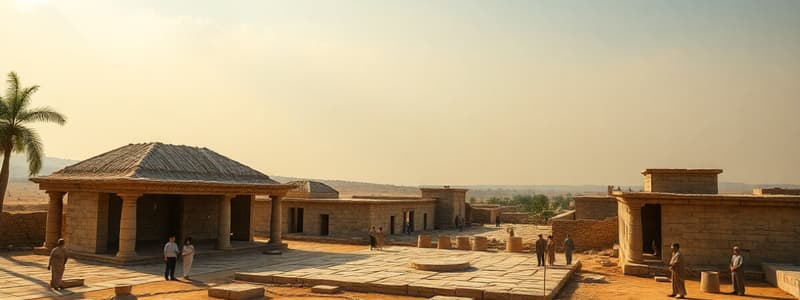Podcast
Questions and Answers
The Sumerian civilization was formed in Mesopotamia around 3300 BC.
The Sumerian civilization was formed in Mesopotamia around 3300 BC.
True (A)
What was the primary function of a Ziggurat in Sumerian cities?
What was the primary function of a Ziggurat in Sumerian cities?
- A place of worship and a city hall (correct)
- A school for educating the youth
- A military fortress for defense
- A marketplace for trading goods
What were Sumerian houses typically built from?
What were Sumerian houses typically built from?
mud
Sumerian cities were surrounded by ______ walls for protection.
Sumerian cities were surrounded by ______ walls for protection.
Match the following features of a Sumerian house with their descriptions:
Match the following features of a Sumerian house with their descriptions:
What did Sumerian priests receive as payment for their services?
What did Sumerian priests receive as payment for their services?
How did Sumerian cities grow gradually?
How did Sumerian cities grow gradually?
Flashcards
Sumer
Sumer
The first civilization formed in 3300 BC in Mesopotamia.
City-state
City-state
A large main city that governs surrounding smaller villages.
Ziggurat
Ziggurat
The most impressive building in Sumer, serving as a temple and city hall.
Life in Sumerian cities
Life in Sumerian cities
Signup and view all the flashcards
Sumerian houses
Sumerian houses
Signup and view all the flashcards
Role of priests
Role of priests
Signup and view all the flashcards
Payment to priests
Payment to priests
Signup and view all the flashcards
Study Notes
Sumer - The First Civilization
- Sumer, a Mesopotamian civilization, emerged around 3300 BC.
- City-states were similar to provinces, with a central city and surrounding smaller villages.
- Trading, religious activities, and training were primarily centered in the main city.
City Life in Sumer
- City development was gradual.
- Roads were winding, not organized in 90-degree angles.
- Protective walls encircled cities, featuring gates.
- Homes were constructed from mud bricks.
- Walls kept out the heat.
- Doors consisted of horizontal beams supported by vertical posts, filled with mud.
- Houses were built around a courtyard, where fires were commonly used.
- Homes featured leaf roofs to allow smoke to escape.
Ziggurat - Temple/City Center
- The Ziggurat, a temple in each Sumerian city, was the most impressive structure.
- Ziggurats functioned as both temples and city halls.
- Priests worked within the Ziggurats.
- People sought advice from the priests regarding the gods.
- Priests received offerings like grains and other supplies.
- Priests gathered and controlled a large portion of the surplus supplies.
- Priests gained significant power as a result.
Studying That Suits You
Use AI to generate personalized quizzes and flashcards to suit your learning preferences.




